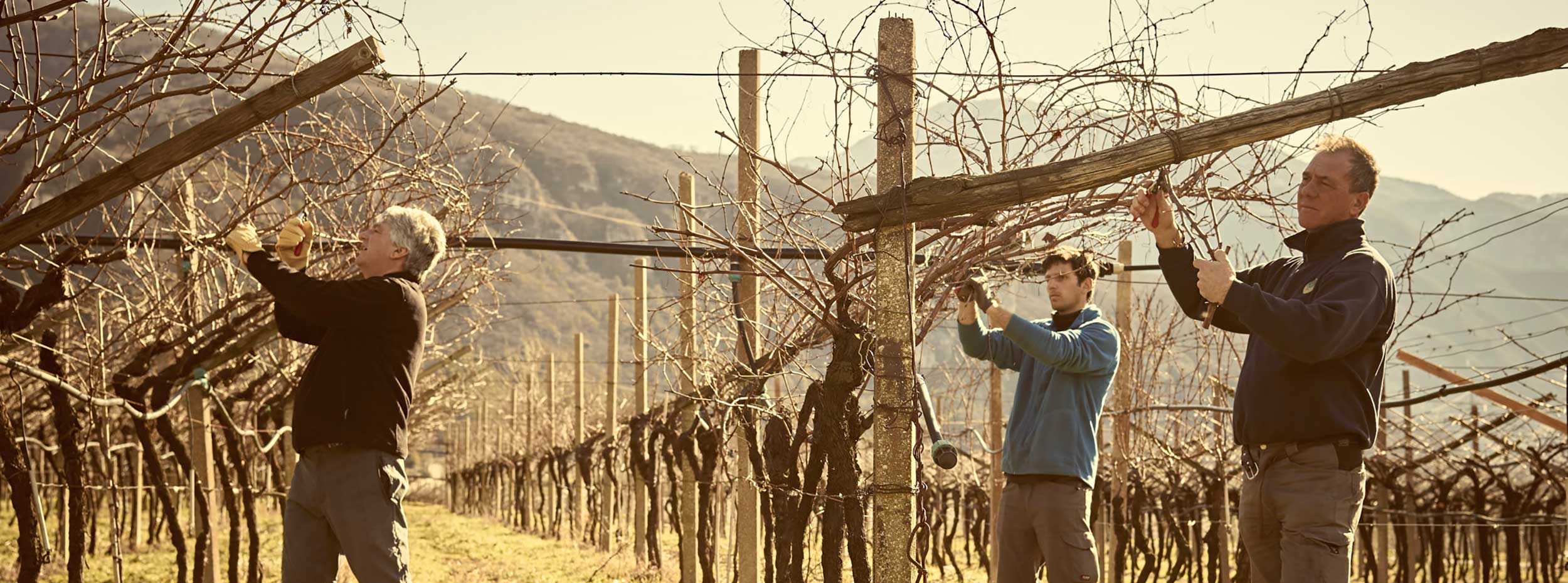
La Cadalora


Situated in the town of Santa Margherita, in the southernmost part of Trentino, the estate of La Cadalora extends its 12 hectares of vineyards in three different plots: about 5 hectares on the calcareous soils close to Marco di Rovereto and the remaning 7 hectares in two calcareous conoids of Valle Cipriana and San Valentino, at the foothills of Monte Zugna. The soils of the latter contain higher percentages of clay while the former are gravelly/sandy and calcarous. In the eighties Rodolfo and Tiziano (a trained oenologist from the renouned Institute of San Michele all’Adige) took over the management of their father’s estate and immediately set to work: the traditional “Pergola Trentina” training system was modified in order to obtain a vineyard density between 5,000 and 8,000 vines/hectare ensuring a maximum of 1 to 1.5 kgs of grapes per plant. Viticulture became strictly environment friendly by eliminating chemicals: “sexual confusion” practice is followed for insect control, only Bordelaise poultice is sprayed and grass is left on the aisles. Green pruning, topping of the vines and deleafing keep the plants balanced and when necessary and depending on the varietal, fruit is thinned by cutting the second cluster or the “wings” of the clusters. The varietals grown are Pinot Grigio, Chardonnay, a little Sauvignon Blanc, Gewurztraminer, Pinot Noir, Marzemino and Casetta (these last two planted right after World War One, Casetta being a very ancient and rare varietal). Tiziano’s son Michele is now working full-time at the estate. He graduated in oenology in Italy and at the renowned University of Geisenheim in Germany with a thesis on forecasting models for vineyard management.
Average annual production
40.000 bottles


Total vineyard extention
13,5 ha
Planted varietals and extension
Pinot Grigio - 6 ha
Chardonnay - 3 ha
Sauvignon - 0,5 ha
Traminer Aromatico - 0,5 ha
Marzemino - 1 ha
Pinot Nero - 1,5 ha
Casetta - 1 ha


Vine training system
Pergola Trentina
Cultivation method in the vineyard
Grass left on the aisles between the vines

Type of viticulture
Practicing organic

La Cadalora

La Cadalora

La Cadalora

La Cadalora

La Cadalora

La Cadalora

La Cadalora

La Cadalora

La Cadalora
Owner Tomasi Rodolfo
Year of Establishment 1982

Agronomist Tomasi Michele and Rodolfo
Winemaker Tomasi Michele and Tiziano
Pinot Grigio - 6 ha
Chardonnay - 3 ha
Sauvignon - 0,5 ha
Traminer Aromatico - 0,5 ha
Marzemino - 1 ha
Pinot Nero - 1,5 ha
Casetta - 1 ha
Situated in the town of Santa Margherita, in the southernmost part of Trentino, the estate of La Cadalora extends its 12 hectares of vineyards in three different plots: about 5 hectares on the calcareous soils close to Marco di Rovereto and the remaning 7 hectares in two calcareous conoids of Valle Cipriana and San Valentino, at the foothills of Monte Zugna. The soils of the latter contain higher percentages of clay while the former are gravelly/sandy and calcarous. In the eighties Rodolfo and Tiziano (a trained oenologist from the renouned Institute of San Michele all’Adige) took over the management of their father’s estate and immediately set to work: the traditional “Pergola Trentina” training system was modified in order to obtain a vineyard density between 5,000 and 8,000 vines/hectare ensuring a maximum of 1 to 1.5 kgs of grapes per plant. Viticulture became strictly environment friendly by eliminating chemicals: “sexual confusion” practice is followed for insect control, only Bordelaise poultice is sprayed and grass is left on the aisles. Green pruning, topping of the vines and deleafing keep the plants balanced and when necessary and depending on the varietal, fruit is thinned by cutting the second cluster or the “wings” of the clusters. The varietals grown are Pinot Grigio, Chardonnay, a little Sauvignon Blanc, Gewurztraminer, Pinot Noir, Marzemino and Casetta (these last two planted right after World War One, Casetta being a very ancient and rare varietal). Tiziano’s son Michele is now working full-time at the estate. He graduated in oenology in Italy and at the renowned University of Geisenheim in Germany with a thesis on forecasting models for vineyard management.
Average annual production
40.000 bottles
Total vineyard extention
13,5 ha
Planted varietals and extension
Pinot Grigio - 6 ha
Chardonnay - 3 ha
Sauvignon - 0,5 ha
Traminer Aromatico - 0,5 ha
Marzemino - 1 ha
Pinot Nero - 1,5 ha
Casetta - 1 ha
Vine training system
Pergola Trentina
Cultivation method in the vineyard
Grass left on the aisles between the vines
Type of viticulture
Practicing organic
Harvest Period
End August - Beginning October